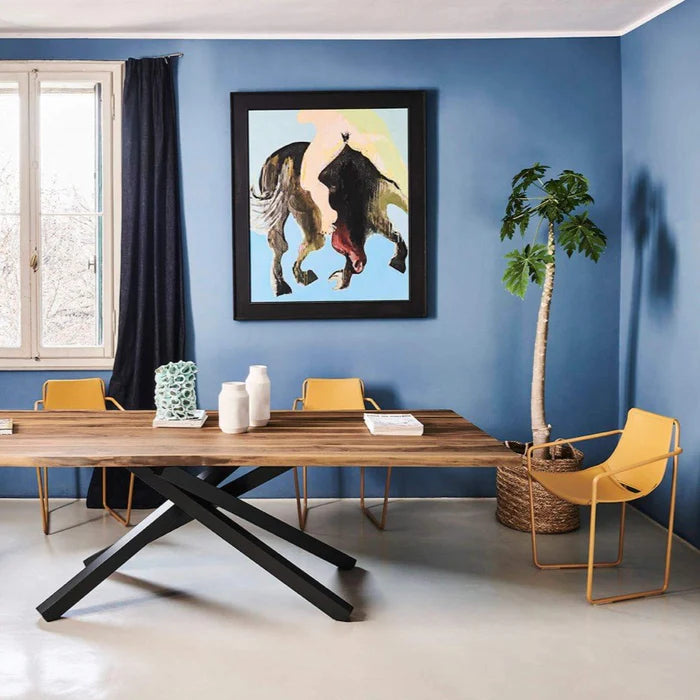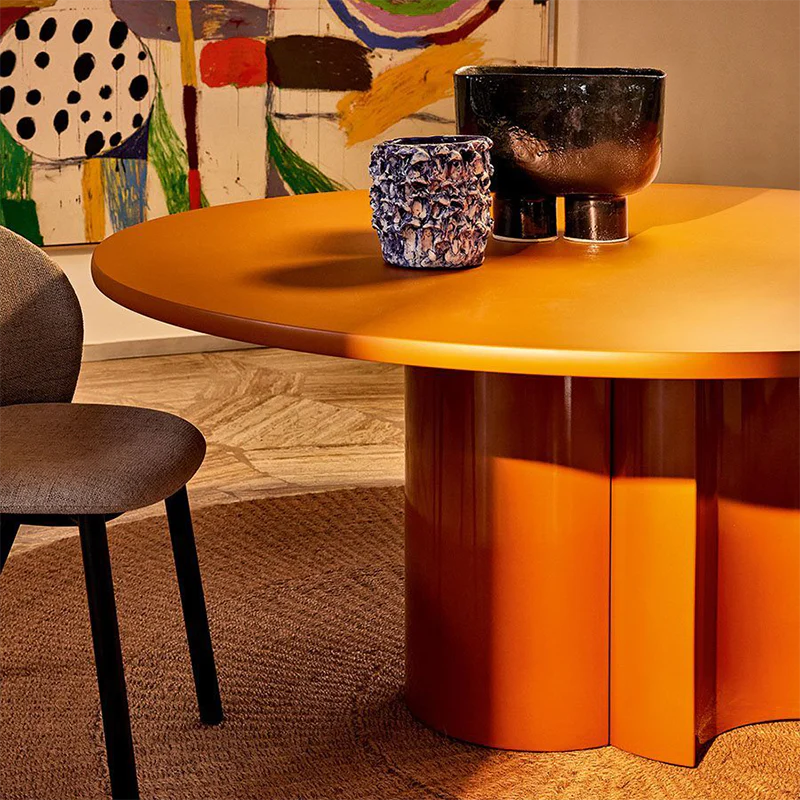
Tailoring Dining Table Heights to Suit Diverse Decor Styles
Understanding Dining Table Heights for Various Decor Styles
The dining table usually forms the centerpiece of the dining space in our homes. More than just a spot to have meals, it also facilitates connections, conversations, and quality time with family and friends.
With evolving lifestyles and preferences, customers’ expectations of the modern dining table have also transformed. As a result, designing this multifunctional furniture now requires a lot of thought and attention to detail. One of the most crucial considerations is determining the ideal dining table height based on your space, decor, and purpose.
Let's explore the significance of dining table heights in the overall dining experience. We'll dive into the standard measurements and learn about height variations that can better complement specific decors or needs. We’ll also provide tips and expert insights. In short, this guide aims to enable you to tailor your dining table height to suit your diverse style.
Why Dining Table Height Matters
The dining table forms the foundation of the dining area functionally and aesthetically. Factors, such as style, material, and color are commonly considered when buying this piece of furniture.
But how often do we think of height when it comes to comfort and functionality? This is a very important factor to consider because an incorrectly proportioned table can disrupt the entire dining experience.
The height of your dining table is especially important because it directly impacts the following key factors:
- Seating comfort and legroom
- Conversation flow across the table
- Ease of getting in and out of the chairs
- Ability to relax arms on the table while eating
- Overall aesthetics and style of the dining space
Choosing the right height for your dining table is very crucial. That’s because it enables you to optimize both comfort and functionality. The table dimensions also provide decor flexibility to seamlessly match diverse decors.
Finding the Sweet Spot: Standard Table Height
With the evolution of different furniture designs over the years, certain standard measurements have also emerged for essential dining room elements. These standards take into consideration ergonomics, as well as the practical spatial needs.
The widely accepted standard height for a dining table falls between 28-32 inches, or 71-81 centimeters. This enables dining chairs to easily slide under the table to save space when not in use. The table surface also aligns comfortably with the diner's chest level when seated. This helps to facilitate ease of eating and engaging in conversations and connections.
This standard table height goes well with dining chairs that are 18-23 inches tall on average. The chairs provide ample legroom and seat depth for most adults to dine comfortably. The surface area of the table also provides convenient usage without furniture crowding.
For round tables, a diameter of 36-42 inches comfortably seats 2 to 4 diners. Rectangular tables are ideal for larger gatherings, with a length spanning anywhere between 60 to 84 inches. Ultimately, the shape and size depends on the number of intended diners and the room’s dimensions.
This universally accepted standard dining table height stems from research on optimal ergonomics and spatial needs, fulfilling both form and function for a seamless dining experience.

Breaking Convention: When to Use Alternative Heights
While the standard dining table height range meets most needs, certain decor styles and purposes call for a variation. Some of the key options include:
A counter height dining table serves to meet casual decor styles
These tables measure between 34-36 inches in height. To complement such a dining table, counter height stools should typically be 24-26 inches tall. The slightly taller table setting lends itself well to a more casual decor and dining style. It's also ideal in situations where the dining space is limited.
Some of the benefits of opting for counter height include:
- Diners can easily get on and off of the tall stools.
- It provides the perfect perch for a quick breakfast or snack.
- It creates an informal and relaxed vibe for casual gatherings.
- It works with bar tools instead of dining chairs, thus saving space.
- It serves to foster a sense of community with shared counter dining.
The counter height table enables you to transform a dining space into one with eclectic character. It also pairs beautifully with stylish modern or industrial style decors. Additionally, the right lighting and decor can help to make it the highlight of the open concept home.
Take the casual dining experience a notch higher with a bar height dining table. These tables have a height of 40-42 inches, which is similar to a bar counter. To complement the extra tall table, bar stools are typically 30-32 inches in height.
Bar height dining tables are perfect for open casual dining areas. Other scenarios where bar height dining tables add value include:
- Hosts who regularly entertain large groups of guests.
- Homeowners who wish to have a bar-style dining experience.
- Large open areas that are used for both work and casual dining.
- Dining niches that are located at a distance from the kitchen counter.
- Dining spaces blending with kitchens or living areas in studio apartments
The bar height table also pairs well with trendy industrial, modern, or rustic chic styles of decor. This provides an air of sophistication while still keeping the space multipurpose and flexible.
Key Factors to Consider When Choosing Dining Table Height
The dining room is not one that has a lot of everyday usage as many people may only use it around and during the holiday season. Despite that, it’s still important that you make the room comfortable and functional. Of course, the entire dining room experience revolves around the dining table.
The height of this furniture can make or break your dining experience. That’s why we’ll walk you through some of the factors you should consider when choosing this piece of furniture in this next section.
-
Assess Primary Users and Purpose
Before settling on a dining table’s height, you need to evaluate who will use the dining space and how often. This includes:
- The scale of your planned gatherings and events.
- Consider whether standing guests need to be accommodated.
- Whether the table will be used for working, playing games, or crafts.
- The age groups likely to use the dining table more frequently and how they’ll use it.
This assessment can help in determining the optimal height that suits your functional needs. Keep in mind that the standard dining table height is ideal for everyday family meals. But if the space will host large gatherings, a counter or bar height option may be ideal.
- Consider the Measurements
You shouldn’t finalize a dining set purchase without measuring your space first. That’s because you must ensure that:
- There’s adequate legroom and seating capacity.
- There’s enough clearance around chairs when seated at the table
- There are sufficient walkways for entry and exit from the dining spots
You must also think about where you’ll place the table. Is there a scenic window or artwork you’d want diners to face? Consider such factors and actual measurements to avoid an inconvenient layout.
-
Seek Expert Guidance
If you need help deciding between standard, counter, or bar height tables, make sure to seek an expert’s advice. Interior designers can suggest the best height based on your space, decor style, and purposes. Furniture designers also have experience suiting different client needs.
Additionally, there are furnishing outlets that provide free planning services. They can help you visualize options digitally or through scaled floor models. Seeking input from an expert can help you determine your optimal dining table height.
-
Matching Chairs and Tables for a Cohesive Look
It’s important that your dining chairs suit the proportions of the dining table height, both aesthetically and ergonomically. Here are some of the key factors that you should consider to achieve that:
- Style: The chairs must match the style, finish, and materiality of the table.
- Comfort: The chairs must have adequate seating depth, back support, and armrests.
- Legroom: Leave about 24 inches between the edge of the table and chair for unconstrained movement.
- Seat height: Get chair seats that are about 10-12 inches below the table height for proper elbow rest.
Note: mismatched dining chair and table combinations can ruin the dining room decor and comfort. Here are some of the standard dining chair heights for common table types:
- For standard dining tables, the chairs should be about 18-23 inches.
- For bar height dining tables, your stools should be around 30-32 inches.
- For counter height tables, your stools should be between 24-26 inches.

Getting these proportions right goes a long way in creating a cohesive and functional dining space that you can truly enjoy. The Bongo Stool, for instance, has a chic and contemporary look that’s ideal for the kitchen and bar areas.
Conclusion
Keep in mind that you must measure your space against the planned dining table height in inches. If you have a classy dining area with a lot of room to spare for family feasts, a regular dining table should serve the purpose.
If you prefer setting up a hangout spot in the kitchen, consider going for a counter or bar height table. Make the perfect choice and get a step closer to your perfect set-up to impress your loved ones and make beautiful memories.
Frequently Asked Questions
Below are the answers to some of the most frequently asked questions on choosing the ideal dining table height:
Why is there a standard dining table height?The standard 28-32 inch height has been established over decades of furniture design refinements. This height ensures optimal ergonomics for most diners based on average heights and seating needs. It allows relaxed dining without hunching or stretching.
Can decorative accents change the effective height?
Yes, some decorative elements can modestly increase or decrease the perceived height of a dining table. For instance, a tall table runner or centerpiece may reduce legroom. Conversely, bold table legs, or a glass tabletop can slightly raise the overall height visually.
For frequently hosting large gatherings of 6 or more, rectangular tables work best. A 6 to 8 feet long rectangular table can comfortably seat 10+ guests and still hold serving dishes, platters, and decor.
Can you request custom dining table heights?Definitely! Custom table heights outside the standard sizes can be designed and built. However, drastically varying from the average can negatively impact ergonomics and spatial planning. Stay close to the standard height for optimal dining comfort.


